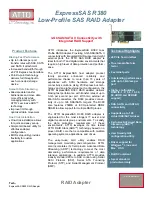
1-2
Cisco Aironet 350 Series Bridge Hardware Installation Guide
OL-1412-01
Chapter 1 Overview
Key Features
Key Features
This section describes the key features of the bridge:
•
Inline power
•
Antenna connectors
•
Ethernet and serial ports
•
Indicator lights
Inline Power
The bridge receives power through the Ethernet cable, so you don’t need to run a separate power cord to
the bridge. Plug the Ethernet cable into the Ethernet port on the back of the bridge and plug the other
end into one of three possible power sources:
•
A Cisco Aironet power injector
•
A switch with inline power, such as the Cisco Catalyst 3524-PWR-XL switch
•
A power patch panel, such as the Cisco Catalyst Inline Power Patch Panel
Note
Cisco Aironet 340 series bridges rely on a separate power supply plugged into the power port on the back
of the bridge.
Caution
Cisco Aironet power injectors are designed for use with 350 series access points and bridges only. Using
the power injector with other Ethernet-ready devices can damage the equipment.
Caution
The operational voltage range for Cisco Aironet 350 series access points and bridges is 24 to 60 VDC.
Higher voltage can damage the equipment.
Antenna Connectors
The bridge is equipped with dual reverse-polarity TNC connectors that you can use to connect to your
own antennas for special applications.
Ethernet and Serial Ports
Ethernet Port
The bridge’s Ethernet port accepts an RJ-45 connector, linking the bridge to your Ethernet LAN. The
350 series bridge receives power through the Ethernet cable from a switch with inline power, from a
power patch panel, or from the bridge’s power injector.















































